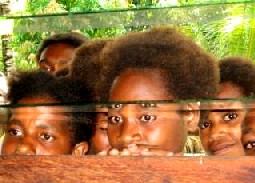 Around 1920 Healthcare in New Guinea started to develop. The growing number of doctors had more and more contact with Papuans and conducted an increasing number of examinations among the population. These were especially aimed at preventing common diseases such as malaria, yaws and tuberculosis.
Around 1920 Healthcare in New Guinea started to develop. The growing number of doctors had more and more contact with Papuans and conducted an increasing number of examinations among the population. These were especially aimed at preventing common diseases such as malaria, yaws and tuberculosis.
Physician Willem Visser lived in the southern part of New Guinea during the 1950’s. At that time, he reported on his experiences and wrote, among other things, about health-care on the south coast. The information in this article comes from his reports.
Contents
1. Southern New Guinea
2. House calls
3. Merauke Hospital
4. The outpatient clinic in Kimaam
5. Campaign against Yaws
6. Links
7. Sources
1. Southern New Guinea
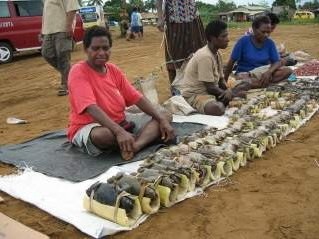 “New Guinea’s south coast is lagging behind a little in development. The first Administrative Post Merauke was established on the left bank of the Maro River, presently the Merauke River. The over-all Merauke area forms the largest district of Southern New Guinea, the others being Mindiptana, Tanah Merah, Kepi and Agats. Each district has its own medical care, its own doctors and its own hospital”. Resident A. Boendermaker was stationed in Merauke itself. Southern New Guinea had some 78.000 inhabitants, 3300 of whom lived in the main centre of Merauke.
“New Guinea’s south coast is lagging behind a little in development. The first Administrative Post Merauke was established on the left bank of the Maro River, presently the Merauke River. The over-all Merauke area forms the largest district of Southern New Guinea, the others being Mindiptana, Tanah Merah, Kepi and Agats. Each district has its own medical care, its own doctors and its own hospital”. Resident A. Boendermaker was stationed in Merauke itself. Southern New Guinea had some 78.000 inhabitants, 3300 of whom lived in the main centre of Merauke.
2. House calls to patients
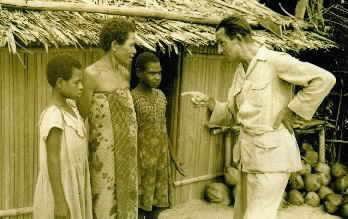 “The doctors, especially the doctors at the outpost, are not sitting waiting for patients who need their help. They would have to wait a long time and have little work. There are still many people living in New Guinea who would rather place their trust in magic and charms. That’s why the doctor goes looking for his patients. The vast area of the Merauke subdivision, 1.33 times the size of the Netherlands, is visited regularly. The 20.000 inhabitants of the Merauke district live dispersed across the area in some 80 villages.
“The doctors, especially the doctors at the outpost, are not sitting waiting for patients who need their help. They would have to wait a long time and have little work. There are still many people living in New Guinea who would rather place their trust in magic and charms. That’s why the doctor goes looking for his patients. The vast area of the Merauke subdivision, 1.33 times the size of the Netherlands, is visited regularly. The 20.000 inhabitants of the Merauke district live dispersed across the area in some 80 villages. 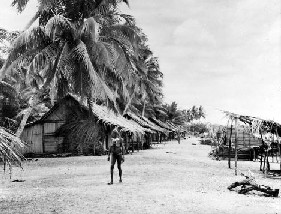
The villages are situated from each other at an average distance of about seven hours travel. By seven hours travel, I mean an average of all possible means of transportation such as motorboat, canoe or on foot. During expeditions lasting several weeks, the doctor visits village after village, examining the population and offering help where needed. This screening shows the doctor in broad terms the needs of a given population. Whether or not certain diseases occur can now be reported on. Projects are then designed in collaboration with the central medical team in former Hollandia to relieve the suffering of the population”
3. Merauke Hospital
“Merauke, the largest subdivision of Southern New Guinea, has a neat little hospital. Too neat in fact,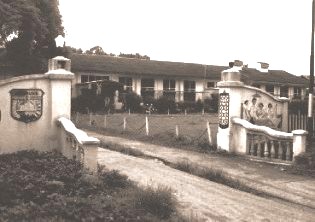 because previously European workers had to put up with a leaking and hot ‘quonset’ ,a prefabricated steel hut. So when the new little hospital was built, it stood in sharp contrast to its surroundings. A shortage of money was everywhere. The uncertain political situation caused all, who went about their task with idealism, to make do in every respect. The first service to struggle out of the continuous need to improvise, was the Public Health Service.
because previously European workers had to put up with a leaking and hot ‘quonset’ ,a prefabricated steel hut. So when the new little hospital was built, it stood in sharp contrast to its surroundings. A shortage of money was everywhere. The uncertain political situation caused all, who went about their task with idealism, to make do in every respect. The first service to struggle out of the continuous need to improvise, was the Public Health Service. 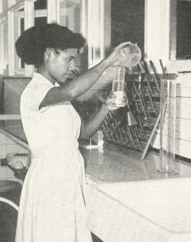
Decent buildings with a capacity of 126 were constructed, which had a well- equipped operatiing theater, sterilisation department, x-ray equipment , outpatient clinic, sewing and linen room, modern kitchen and nurses’ home. A European medical staff was employed, consisting of three doctors and eight nurses (four of whom belong to a religious order). Along with the Indonesian and indigenous personel, made up of qualified nurses and nurse-aids, they provide the medical care for the entire subdivision from this centre. In addition, some forty native Papuan boys and girls are being trained as kampong nurses (special nurse-aids who move around to work in local Papuan villages.”
4. The outpatient clinic in Kimaam
“Frederik Hendrik Island is the hardest area of the district to navigate. One travels in a small patrol  boat over the always choppy Arafura Sea to the main kampong (village) of this island, called Kimaam. In Kimaam, the governmental post and main center of Frederik Hendrik Island, a religious nurse, sister Adele, is managing the small outpatient clinic. She is in charge of the kampong’s healthcare. Papuan girl, who were trained as nurse aids, have been placed in the larger villages on Frederik Hendrik Island. They know how to treat the most common diseases and they also give advice about food and hygiene to (expectant) mothers.
boat over the always choppy Arafura Sea to the main kampong (village) of this island, called Kimaam. In Kimaam, the governmental post and main center of Frederik Hendrik Island, a religious nurse, sister Adele, is managing the small outpatient clinic. She is in charge of the kampong’s healthcare. Papuan girl, who were trained as nurse aids, have been placed in the larger villages on Frederik Hendrik Island. They know how to treat the most common diseases and they also give advice about food and hygiene to (expectant) mothers. 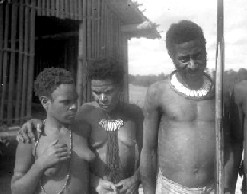 This way, we hope to reduce, among other things, the very high (25-50 percent) infant mortality. European nurses are in charge of this project. Kimaam does not have contact with the outside world very often. People are very happy if there is a boat from Merauke once a month. Sister Adele’s work is succesful. The kampong population is getting used to the perawats, as the Kampong (village) nurses are called here. Their position was a little difficult at first. After all, people are not used to and do not appreciate attributing a level of authority to a woman. Women’s work is preparing sago, going fishing and having children. All the same, some mothers do go to see the parawat with their sick children and when the parawat turns out to be able to heal them, their position is strengthened and people accept her. The parawats are vital to the extremely isolated villages on Frederik Hendrik Island.”
This way, we hope to reduce, among other things, the very high (25-50 percent) infant mortality. European nurses are in charge of this project. Kimaam does not have contact with the outside world very often. People are very happy if there is a boat from Merauke once a month. Sister Adele’s work is succesful. The kampong population is getting used to the perawats, as the Kampong (village) nurses are called here. Their position was a little difficult at first. After all, people are not used to and do not appreciate attributing a level of authority to a woman. Women’s work is preparing sago, going fishing and having children. All the same, some mothers do go to see the parawat with their sick children and when the parawat turns out to be able to heal them, their position is strengthened and people accept her. The parawats are vital to the extremely isolated villages on Frederik Hendrik Island.”
5. Anti-yaws campaign
“A program combatting Yaws, sponsored by UNICEF and WHO, was carried out in New Guinea in 1957. Yaws is an illness causing many ulcers to spread all over the body. At a later stage, bones 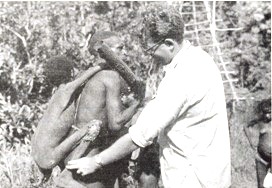 can be affected and various deformities occur. Ten percent of the population is infected. Most of the victims are children. Hundreds of flies gather on the ulcers and cause horrible suffering. It is very difficult to reach the full hundred percent of the population (for inoculation). Lack of interest, fear and ignorance cause many people to decide to disappear at the last moment.” In all governed regions, everybody was given a PAM injection, regardless of whether they were suffering from the disease or not. PAM is a type of penicillin solution, curing yaws within a few
can be affected and various deformities occur. Ten percent of the population is infected. Most of the victims are children. Hundreds of flies gather on the ulcers and cause horrible suffering. It is very difficult to reach the full hundred percent of the population (for inoculation). Lack of interest, fear and ignorance cause many people to decide to disappear at the last moment.” In all governed regions, everybody was given a PAM injection, regardless of whether they were suffering from the disease or not. PAM is a type of penicillin solution, curing yaws within a few 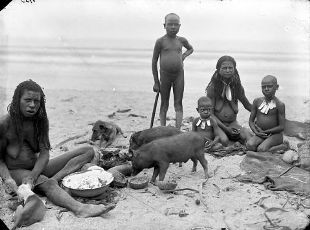 days of being given just one injection.Everybody receives an injection because there are many latent cases of the disease. These individual are also freed from the germs that cause the disease, preventing it from breaking out. It is important to reach as many people as possible. After all, if only one person suffering from yaws remains, this person can re-introduce the illness among the entire population. As part of this major preventative campaign, a tour of the villages was made. Obviously, there is a chance that everyone will be reached in this way. If the full hundred percent of the population is indeed reached, the case is closed and yaws will have been eradicated.
days of being given just one injection.Everybody receives an injection because there are many latent cases of the disease. These individual are also freed from the germs that cause the disease, preventing it from breaking out. It is important to reach as many people as possible. After all, if only one person suffering from yaws remains, this person can re-introduce the illness among the entire population. As part of this major preventative campaign, a tour of the villages was made. Obviously, there is a chance that everyone will be reached in this way. If the full hundred percent of the population is indeed reached, the case is closed and yaws will have been eradicated.
6. Links
7. Sources
-W.M. Visser M.D, Reizen in Zuid-Nieuw Guinea in de vijftiger jaren (private publication) -W.M. Visser M.D., Arts en explorateur aan de Casuarinekust, Schakels jaargang 60
-Klein, W. C., Schumacher, C., Bierdrager et al, Nieuw Guinea: De ontwikkeling op economisch, sociaal en cultureel gebied, in Nederlands en Australisch Nieuw Guinea, Staatsdrukkerij en uitgeverij, 1935-1937